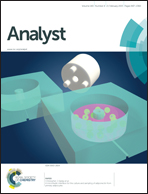Sorting of human mesenchymal stem cells by applying optimally designed microfluidic chip filtration
Abstract
Human bone marrow-derived mesenchymal stem cells (hMSCs) consist of heterogeneous subpopulations with different multipotent properties: small and large cells with high and low multipotency, respectively. Accordingly, sorting out a target subpopulation from the others is very important to increase the effectiveness of cell-based therapy. We performed flow-based sorting of hMSCs by using optimally designed microfluidic chips based on the hydrodynamic filtration (HDF) principle. The chip was designed with the parameters rigorously determined by the complete analysis of laminar flow for flow fraction and complicated networks of main and multi-branched channels for hMSCs sorting into three subpopulations: small (<25 μm), medium (25–40 μm), and large (>40 μm) cells. By focusing with a proper ratio between main and side flows, cells migrate toward the sidewall due to a virtual boundary of fluid layers and enter the branch channels. This opens the possibility of sorting stem cells rapidly without damage. Over 86% recovery was achieved for each population of cells with complete purity in small cells, but the sorting efficiency of cells is slightly lower than that of rigid model particles, due to the effect of cell deformation. Finally, we confirmed that our method could successfully fractionate the three subpopulations of hMSCs by analyzing the surface marker expressions of cells from each outlet.


 Please wait while we load your content...
Please wait while we load your content...